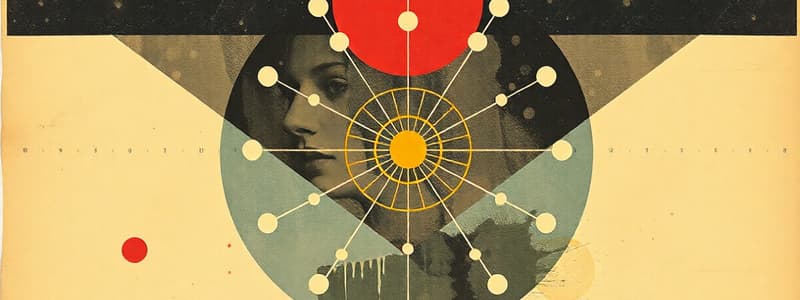Podcast
Questions and Answers
What is the charge of a neutron?
What is the charge of a neutron?
- +1
- +2
- 0 (correct)
- -1
Where are electrons located in an atom?
Where are electrons located in an atom?
- Attached to the outside of the atom
- Orbiting the nucleus in orbitals (correct)
- In the nucleus with the protons
- In the nucleus with the neutrons
According to the Bohr model, what does a dot with a minus sign inside represents?
According to the Bohr model, what does a dot with a minus sign inside represents?
- A neutron
- A proton
- The charge of the nucleus
- An electron (correct)
What do the dots in a Lewis dot structure represent?
What do the dots in a Lewis dot structure represent?
Which of the following is an example of a compound?
Which of the following is an example of a compound?
What is a molecule?
What is a molecule?
What does the atomic number of an element represent?
What does the atomic number of an element represent?
What is the chemical symbol?
What is the chemical symbol?
Which of the following best describes the trend of atomic radius on the periodic table?
Which of the following best describes the trend of atomic radius on the periodic table?
Why are noble gases generally considered non-reactive?
Why are noble gases generally considered non-reactive?
Which of these properties is characteristic of nonmetals?
Which of these properties is characteristic of nonmetals?
In the compound $H_2O$, what does the subscript '2' indicate?
In the compound $H_2O$, what does the subscript '2' indicate?
What is the purpose of using coefficients in a chemical equation?
What is the purpose of using coefficients in a chemical equation?
What is the key difference between ionic and covalent bonding?
What is the key difference between ionic and covalent bonding?
In a polar covalent bond, what causes one atom to have a partial negative charge?
In a polar covalent bond, what causes one atom to have a partial negative charge?
What is ionization energy?
What is ionization energy?
Flashcards
Nucleus
Nucleus
The center of an atom, containing protons and neutrons.
Electrons
Electrons
Negatively charged particles orbiting the nucleus.
Element
Element
A pure substance composed of only one type of atom.
Compound
Compound
Signup and view all the flashcards
Mixture
Mixture
Signup and view all the flashcards
Atom
Atom
Signup and view all the flashcards
Molecule
Molecule
Signup and view all the flashcards
Atomic Number
Atomic Number
Signup and view all the flashcards
Atomic radius
Atomic radius
Signup and view all the flashcards
Electron affinity
Electron affinity
Signup and view all the flashcards
Ionization energy
Ionization energy
Signup and view all the flashcards
Covalent bonding
Covalent bonding
Signup and view all the flashcards
Ionic bonding
Ionic bonding
Signup and view all the flashcards
Metals
Metals
Signup and view all the flashcards
Nonmetals
Nonmetals
Signup and view all the flashcards
Noble gases
Noble gases
Signup and view all the flashcards
Study Notes
Subatomic Structure
- Protons are positively charged (+1) and located in the nucleus.
- Neutrons are neutrally charged (0) and located in the nucleus.
- Electrons are negatively charged (-1) and located in orbitals surrounding the nucleus.
- Atoms with full outer electron shells (valence electrons) are less reactive.
Nucleus vs. Orbitals
- The nucleus, at the atom's center, contains protons and neutrons.
- Orbitals, surrounding the nucleus, contain electrons.
Bohr Model
- Represents an atom with a nucleus (containing chemical symbol and proton number)
- Shows orbitals represented by dots with minus signs representing electrons.
Lewis Dot Structures
- Show an atom's chemical symbol surrounded by dots representing valence electrons.
- Valence electrons are the outermost electrons.
Classifying Matter
- Elements: Composed of identical atoms; a pure substance (e.g., Carbon, Silver, Gold, Aluminum).
- Compounds: Pure substances made of two or more elements in a fixed ratio, with different properties than the original elements.
- Mixtures: Variable combinations of two or more pure substances; types include suspensions, colloids, and solutions.
Atoms vs. Molecules
- Atoms: Smallest unit of matter retaining element properties.
- Molecules: Neutral groups of atoms joined by one or more covalent bonds.
Periodic Table
- Atomic Number: Number above the element abbreviation, indicating the number of protons (equal to the number of electrons).
- Atomic Mass: Usually at the bottom of the element box.
- Chemical Symbol: One or two letter abbreviation for element name (e.g., Chlorine = Cl).
Periodic Table Patterns and Properties
- Atomic Size/Radius: Increases moving down and to the left.
- Reactivity: Greatest in lower left and upper right corners. Noble gases (far right column) are non-reactive due to full valence shells.
Metals, Nonmetals, Noble Gases
- Metals: Good conductors of heat and electricity, lustrous, malleable, and ductile.
- Nonmetals: Mostly gaseous at room temperature, brittle, poor conductors.
- Noble Gases: Gases with full valence shells, non-reactive.
Chemical Formulas
- Subscripts: Indicate the number of atoms of an element in a compound (e.g., CO₂ has two oxygen atoms).
- Chemical Symbols: Abbreviations for elements' Latin names.
- Coefficients: Used in chemical equations to balance the number of atoms on both sides.
Ionic vs. Covalent Bonding
- Ionic Bonds: Atoms transfer electrons to attain a neutral charge, forming a new compound.
- Covalent Bonds: Atoms share electron pairs to achieve stable electron configurations.
- Polar Covalent Bonds: One atom has a greater attraction for electrons, creating partial positive and negative charges.
Ionization Energy (Electron Affinity)
- Energy needed to remove an electron.
- Increases moving up and to the right on the periodic table.
Studying That Suits You
Use AI to generate personalized quizzes and flashcards to suit your learning preferences.




